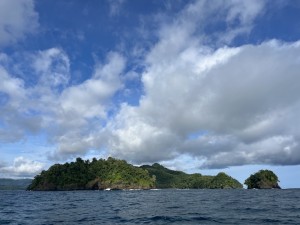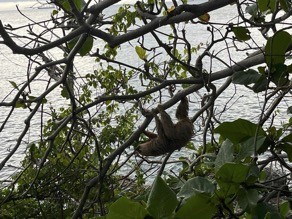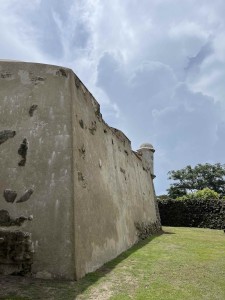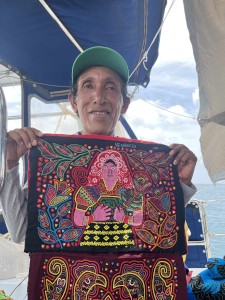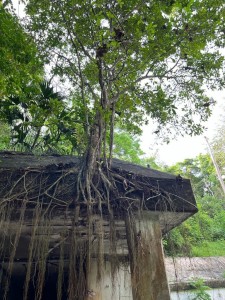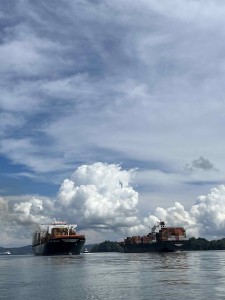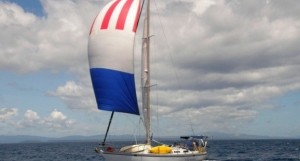Tokimata's Travels
| Vessel Name: | Tokimata |
| Vessel Make/Model: | Ganley S130 steel cutter |
| Hailing Port: | Coromandel, New Zealand |
| Crew: | Peter, Rachel, Danny and Tom Garden |
06 September 2023 | Bahia Nonda
Panama Pacific Coast
It’s now well over a month since we left Panama City. La Brisas the free anchorage on the long causeway joining three islands, was free but not the greatest pace to stay, with poor holding and many disintegrating boats, but this amazing backdrop of skyscrapers behind. These free places where yachts [...]
07 August 2023
Panama City
We fuelled up on 20th July 2023 and filled with water, ready for the passage through the Panama Canal. We were to leave around 2 pm next day, staying overnight in Gatun lake with our local line-handlers, and should be through by 3 pm on the following day.
21 July 2023
Rio Chagres and Portabelo on the Caribbean coast of Panama.
We left the San Blas islands on July 10 2023, after a last visit to Ivin, the wonderful chef at Hollandais Cays. He gave a few more image files for his recipe book and we bought his terrific coconut cake one last time. At 11.30 we upped anchor and were off on our way back east, the transit through the [...]
13 July 2023
The islands of San Blas
On Friday 23rd June at last we headed across the busy canal entrance from Shelter Bay marina and into the Caribbean sea. We were sailing to the San Blas islands, Kuna Yala to the inhabitants, hundreds of small islands and coastal villages that are still administered by the indigenous owners of the land. [...]
30 June 2023
The jungles of Panama
Grinding rust on the hull of Tokimata eventually gave way to grinding rust on the decks, but this was made much easier by hiring energetic boatyard workers. Eventually this progressed to painting, using two part polyurethane over the various anti-rust treatments and primers they had applied. However [...]
07 June 2023
Two weeks in Panama
We arrived in Panama City Tuesday 23rd May from Manchester, with our usual heavy luggage: this time a Starlink system was the bulk of it along with other boat essentials. After travel via Amsterdam we arrived at last to see our taxi-driver holding a “Mr Peter” sign and were off for the hour and a [...]
The green of Greenland
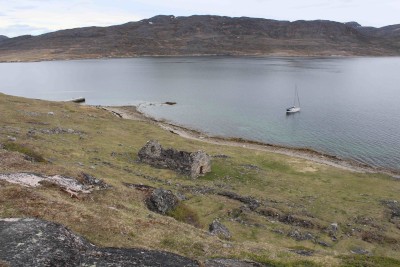
On Sunday June 9th we left Tuttutooq island, on the edge of this area, with its reindeer farm and geologists, and moved on way up near the mainland in their main sheep farming area originally settled by the Norse in 985. Here are again sheep farms - bare slopes of verdant green, already ploughed and sown and even a few animals let out to graze, spry leggy sheep with little horns and lambs already at foot, some hairy small horses and a few cattle too.
Past Narsaq to Narsarsuaq we came to the fjord where the ruins from the original farmsteads of 985 of Eric the Red are still evident. In Eric the Red's time a hundred or so souls travelled here from Iceland, the Inuit had not come this far south at that time. At the Norsemen's peak a few hundred years later there were 5000 or so on more than 200 farms here and in the fjords of Nuuk. But by 1450 they were all gone. An interesting historian at the local museum argued they probably simply moved back to Europe to take up opportunities presented by the huge mortality of the plague from the 1300's on, leaving just the best farms occupied and too small a community to survive once the Inuit were here competing for resources.
After our visit to Narsarsuaq we motored across to Qassiarsuk, through icebergs to get to Eric the Red's farm, we walked among the ruins, rather lovely art work on cliffs above, copper shapes on a rocky face, and reconstructed long house and tiny church, both turf covered and extraordinarily beautiful. A local, Lars, showed us around, small, fine boned, very elderly. A modern farm is built among the ancient ruins and much stone was used for the modern houses from the ancient ruins until this was stopped in 1928.
Icebergs in the fjord meant we needed to move on so we motor-sailed down to Itilleq, anchoring in a bay near a farm. Next day, Tuesday, was amazingly warm and sunny, eventually we were basking in 24 degrees as we walked on a gravel road over a ridge to Igaliku, Norse Gardar, seat of their Bishop and strange pink granite ruins. The walk took us between farms all framed by these huge snowy mountains. A few sleepy hostels and cafes were in the tiny settlement, as in the Pacific closed and half asleep but spring to life when the few flights in the region start from Copenhagen still a week or so away. The large farms are familiar from NZ with NZ style equipment and eartagged sheep, electric fences, but also huge indoor sheds for housing stock in winter.
On Wednesday we went south, and missed Narsaq again as the wind was unfavourable We actually tied up in the harbour but the wind was blowing onto the dock pushing us against the huge truck tyres, and the 4 metre tide range and a 5m iceberg bumping along the pier persuaded us to move on and find a bay of our own. Anchoring just a couple of miles away in a nice cove we had dinner and then noticed a huge berg heading straight for us pushed along by the outgoing tide. As it approached we motored forward a few metres while still anchored and let it bump past us with a few encouraging pushes from the ice poles before relaxing again with no further berg problems
The next day we passed Qarqatoq en route to Hvalsey. One of the most complete and beautiful ruins of a church is there, very simple on the side of a slope, not as elsewhere in the heart of a farm. Perhaps for this reason the stone was not used for other things and the church walls are very fine and simple, originally plastered and painted white they think, now bare stone with wonderful bright lichens. The settlement very clearly laid out.
We anchored nearby then made our way back to Qarqatoq where we'd seen a large yacht tied up to the pier, and we rafted alongside the Dutch yacht Bo. Ron and wife and daughters, on board, 5 and 7. They'd travelled from Newfoundland and hit bad weather on the way, still recovering, and we were able to provide them with our old Dell laptop since theirs had been hit by water en route. Qarqatoq was great but we needed to move on as bad weather was coming - went in behind Nanortalik, anchored in calm behind the town dump. It was very shallow on the sheltered side of town but we found an 11m deep hole and anchored in that.
Sunday 16th we spent holed up in Tokimata in a violent storm: gusting over 50 knots while we monitored it from instruments in the cockpit and now and then as we stay below seems even worse - the hull pushed right over as if we were underway, a great screaming of wind around the mast, banging and clanking in the rigging, and the flapping of our clears... altogether this is weather one dreads to be out at sea in ...
Monday all was calm and after pulling the mud encased anchor up by motoring forward - the windlass wouldn't budge it - we motored around to the main harbour of what turned out to be a pretty little town with friendly people. We visited their museum which in an entire "colonial area" of old buildings and an enthusiastic guid who spoke no english - he dragooned a danish visitor into translating, the poor thing was kept pretty busy... Nanortalik also has a great tourist office when Niels the retired local headmaster runs a fine operation and helped us get the latest ice information for Cape Farewell and phoned the weather station and friends in Price Christian Sound to check things out for us. The consensus was that our way out east was still blocked by thick ice (the weather station officer said "only a fool would try it"). So we decided to move a little further south and head up the Tasermiut Fjord where we anchored at a small settlement. Lone;y Planet rates this fjord as one of the most spectacular in the world and it is a mecca for rock climbers because of its sheer 2 to 3000 foot rock walls rising straight from the sea. Unfortunately the weather was overcast and dreary now and we saw very little of that. We would head back to Nanortalik the next day to check on the ice situation again to see if we could get away around Cape Farewell.
